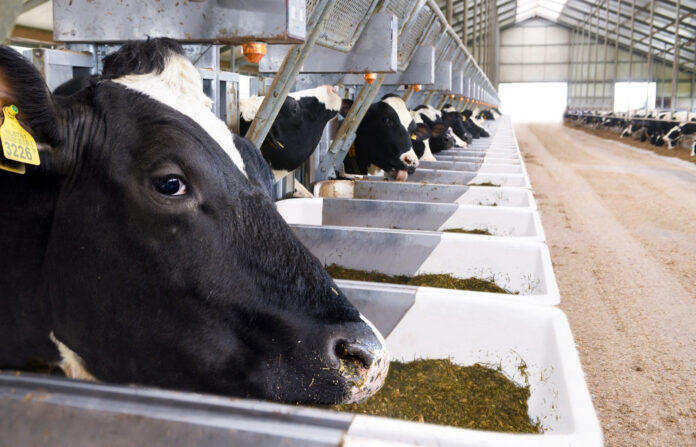CONCEPT OF EMERGING MODELS OF DAIRY FARMING IN INDIA
In India, an estimated eight crore rural families are engaged in dairy production and the rural market consumes over half of the total milk produce4, 20 & 21. About 75% of milk is consumed at the household level and is not diverted to manufacturing of commercial dairy products28 . Fresh milk has a larger market in India as it is liked by most of the consumers. Most of the farmers keep 1-5 dairy animals for their family requirement and rest of the milk is sold locally. Besides that, the growing concerns in dairy farming are shrinkage of resources for fodder production, grazing facility, degradation of common grazing lands, low productivity and profitability. Henceforth, commercialization in dairy farming is the need of the hour. Today, one of the emerging trends in Indian dairying is the growing number of commercial dairy farms in the urban and peri-urban areas of the metros and educated people, which is very uncommon in traditional dairy farming. Therefore, with growing urbanization and unfolding globalization the demand for high value products is increasing. The Indian dairy farming system is witnessing a gradual transformation from traditional production to commercial production during the last decade. The current growth rate of milk production is 6.62 % only. The target of 341 MT (2033-34), can be achieved only through the growth rate of 9.2-15%, which in turn reflects the opportunity of commercial dairy farming 3 , which is remunerative and capable of giving a return on the investment to a tune of 20-30% or more20 . Creating employment opportunities to convert small and medium-scale dairy farming into commercial farming ventures is another dimension. Further, the ever-increasing demand for milk cannot be ignored due to the growth of three key drivers, population, urbanization and per capita income39. Indian dairying has a massive and mounting domestic market in which milk consumption is constantly rising in concord with the increase in purchasing power of people, increasing urbanization, changing food habits and lifestyle, and demographic growth.
EMERGING MODELS OF DAIRY FARMING IN INDIA
A number of innovative models are conceivable/are emerging in various parts of India in order to address the challenges mentioned above. Some of these models are:
Large Scale Dairy Farms
Large scale Integrated dairy farms have facility for housing over 1,000 high yielding crossbred cows, with automated milking, feeding, milk processing and integrated feed production. Ownership and responsibility for the operation and maintenance of the farm lies with an anchor/organised player. The organised player may enter into contract farming with the farmers for procurement of green fodder, a key input for enhancing milk yield of cattle. The milk is either sold to other dairies or used for processing into value added milk products at its own plant. The significant benefit of this model is efficiency in scale of operations, end to end product traceability and high level of product and process control. This model is suitable for large cooperatives and corporates.
Figure 1: Large Scale Dairy Farms
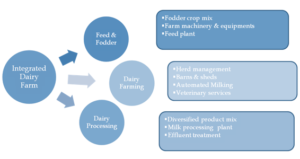
Hub and Spoke Model
The main farm (Hub), owned by an anchor organization has all the integrated facilities like automated milking, feed production and milk processing with a cattle count of over 500 cows. The connected/satellite farms (spokes), with 50 to 200 cattle each, have basic infrastructure for milking and cattle management and are owned by progressive dairy farmers/rural entrepreneurs in close proximity to the main farm (less than 100 km distance). The main farm provides technical support (veterinary care, feed management, training) to the satellite farms. This model offers the benefits of end-to-end product traceability and reasonable level of product and process control, although with significantly lesser capital expenditure by the Anchor. Critical to this model are the control systems that need to be put in place to ensure that farm management administration is of desired level and that milk output quality adheres to the set standards. Further, versus the Single Location Large Scale model, the land requirement is distributed over multiple locations. The model is also more socially inclusive and lends itself to faster scale up.
Figure 2: Hub and Spoke Model
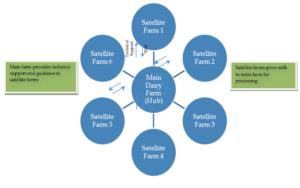
The constraining factor impacting profitability in both of the above models is the low milk yields of up to 3,600 litres per cow per year for existing crossbred cows in the Indian scenario as compared to EU-27, US and Israel with average milk yield of 6,692 litres, 9,865 litres and 11,706 litres respectively. Framing and implementation of an enabling policy structure that facilitates import of high yielding cattle and intensified efforts on cattle breeding programmes for indigenous breeds shall be significant initiatives in overcoming the challenge of low yields.
Progressive Dairy Farming Model
With some support from an anchor processor, a number of progressive farmers are scaling up their current herd size to establish mid-sized dairy farms with 200 to 300 cattle. Farms in this case are semi-automated for milking and feeding. This is an entrepreneurship model wherein the anchor without incurring substantial capital expenditure benefits from an assured supply of milk of traceable, consistent and good quality. The anchor provides technical support (veterinary care, feed management, training) and financial support (directly or through financial institutions) to the farms. Government also provides support to small farmers for purchase of cattle and also by way of administration of breeding programmes. This model is constrained by way of limited capital investment capability of the progressive farmers and is also challenging in terms of the anchor’s ability to have a fool proof mechanism to ensure checks and controls on the farm operations. However if replicated, this can be an excellent partnership between farmers and processors and can be a win-win model for all stakeholders in the long run.
Figure 3: Progressive Dairy Farming Model
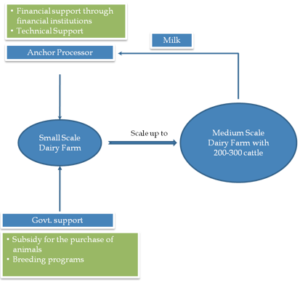
Community Dairy Farms
Collective dairy farming is based on the concept of building “hostels” for cows. It has been successfully implemented in countries such as China. Development of such models help farmers achieve economies of scale and also result in better dairy management systems. This model envisages investment in farm infrastructure by an anchor (corporate, cooperative, government) and cow stalls are leased out on nominal charges to individual farmers, who are responsible for housing of cows and managing them under guidance of the anchor. Automation level of the farms can be a function of the farm size. The milk would be purchased under buy-back arrangement by the anchor. This model enables the smallest of the dairy farmers to avail the benefits of technology, scale and systems.
Figure 4: Community Dairy Farms
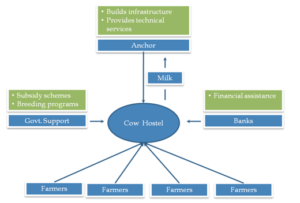
Lead Farmer Model
In this model, a lead farmer establishes common farm infrastructure required for housing, breeding, feeding and milking of animals. The model works on the lines of community dairy farming, with a difference that the ownership and management of infrastructure lies with the lead farmer and not with an investor/anchor. Milking machines, equipment, bulk coolers and milk storage facilities are owned by the lead farmer. Individual farmers are responsible for housing their cows and managing them under the guidance of the lead farmer in stalls provided to them on a rental basis. Milk produced is sold to a processor who provides technical assistance to the farmers. This model is sustainable and scalable under the farmer producer organisation structure as well.
Figure 5: Lead Farmer Model
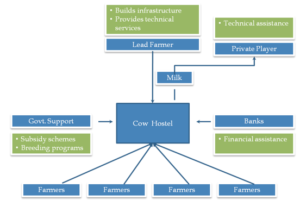
KEY ENABLERS FOR EFFECTIVE IMPLEMENTATION OF DAIRY FARMING MODELS
The following key enablers would pave the way for effective implementation of various dairy farming models:
Utilization of Feed & Fodder Resources
With rapidly shrinking land and natural resources, sourcing of feed and fodder is challenging the very aim of augmenting milk production in India. Application of newer tools of technology to produce large scale feed blocks, feed enzymes and other innovative feed resources need to be enhanced. This coupled with the efficient cultivation and harvesting techniques including irrigation management can greatly improve the fodder production in the country.
The following imperatives assume significant importance to optimize the feed and fodder production and management:
- Maximize the usage of crop residues and leguminous forages. Use Research and Development (R&D) interventions to enhance the nutritional quality and adaptability of crop residues and forage crops.
- Treatment of cereal straws, use of urea-molasses mineral blocks, maize and sorghum stovers, spent tea leaves etc. through a participatory approach involving farmers.
- Explore the possibilities of additional sources of feed supply like intercropping with cereal crops, relay cropping, food-feed systems etc to ensure year-round feeding systems and counteract seasonal scarcities.
- Effective utilization of an integrated watershed development approach towards evolution of fodder production systems.
- Promote quality fodder production through effective seed production, harvesting, processing, storage and marketing systems.
Facilitation of Knowledge & Technology Transfer
Advanced and computerised milking and feeding systems, cow-cooling systems as well as milk processing equipment are some of the areas where joint ventures and strategic alliances with the international technology providers can bring in the desired level of improvements. The following steps need to be taken to facilitate technology infusion and knowledge transfer to scale up milk productivity:
- The government should promote selective import of heifers and frozen semen from countries like Israel whose genetic sources have the potential for better adaptation and performance under our climatic conditions. This paves the way to improve the existing genetic potential of the Indian cattle.
- Knowledge transfer to understand successful international models of dairy farming that could be adopted in India.
Concrete strategies which set the directions to increase profitability, sustainability and competitiveness for Indian dairy farmers.
Figure 6: Key Components of Dairy Farming Strategy
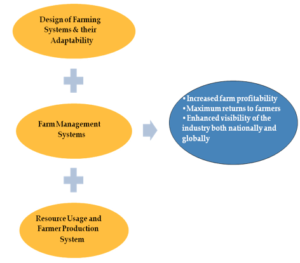
Government Policy Support
Government is providing support to the dairy sector through various development schemes. Along with these supporting policies, the following initiatives will also help in giving an impetus to this sector:
- Suitable incentives by the central and state governments, including subsidy to private investors on plant and machinery, single window clearance and subsidised basic infrastructural support like power and water for such projects.
- The Government should encourage private sector participation by providing land for the project as well as setting-up the project and managing the operations.
The stress on dairy production systems necessitates the development of innovative and scalable commercial dairy farming models. Enabling government policy along with innovative approach of the private sector will play a key role in defining the success of these initiatives. However, the drivers of success for each model need to be tested on the ground. Due to the current diversity in nature of farming systems, prevailing infrastructure, farmer capacities, socio-cultural realities, climatic patterns, multiple models/structures of organizations, there will not be a single model that shall fit all requirements in all circumstances. Rather a mix of various models is going to evolve and determine the landscape of commercial dairy farming in India.
Compiled & Shared by- This paper is a compilation of groupwork provided by the Team, LITD (Livestock Institute of Training & Development)
Image-Courtesy-Google
Reference-On Request


